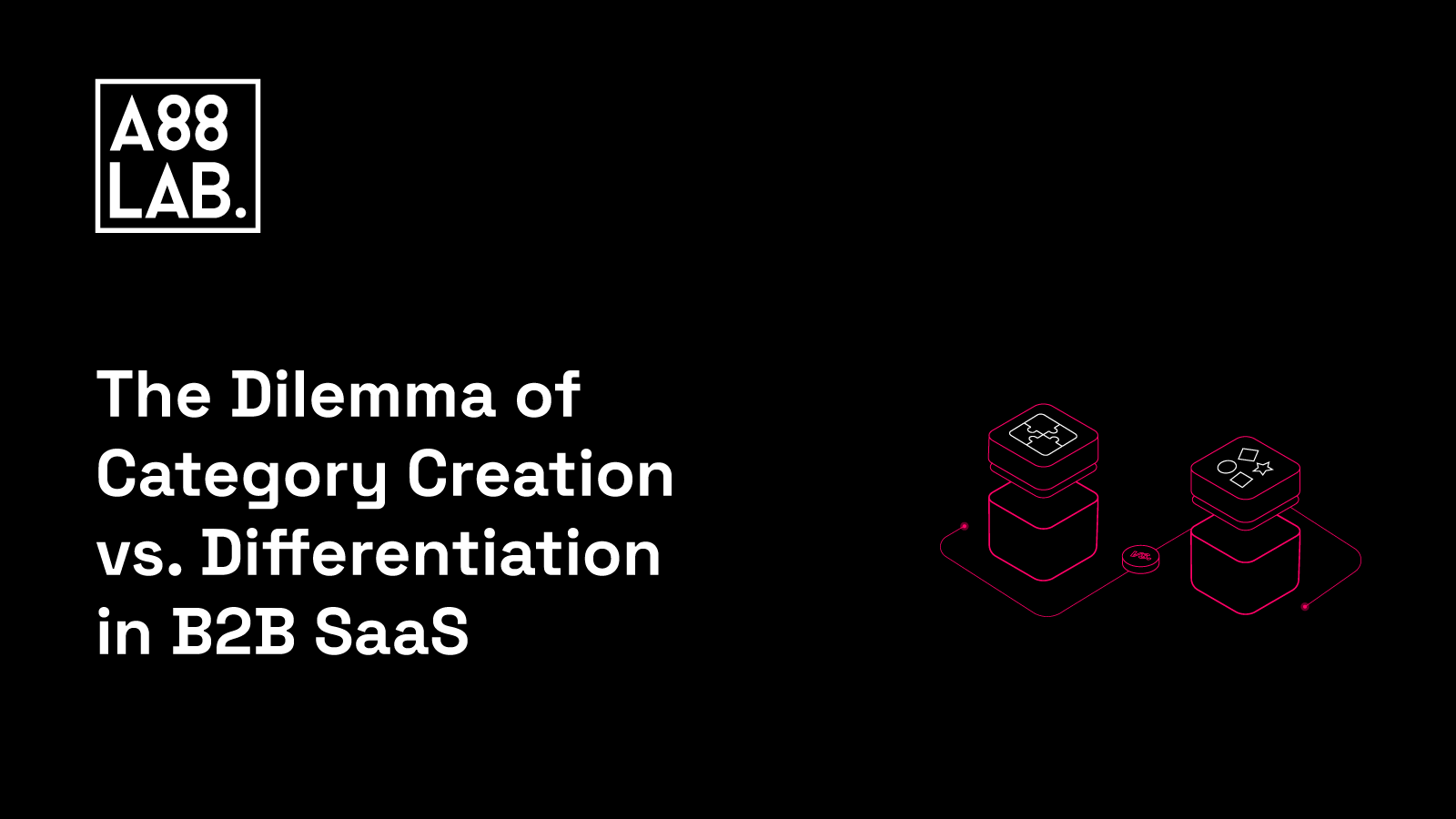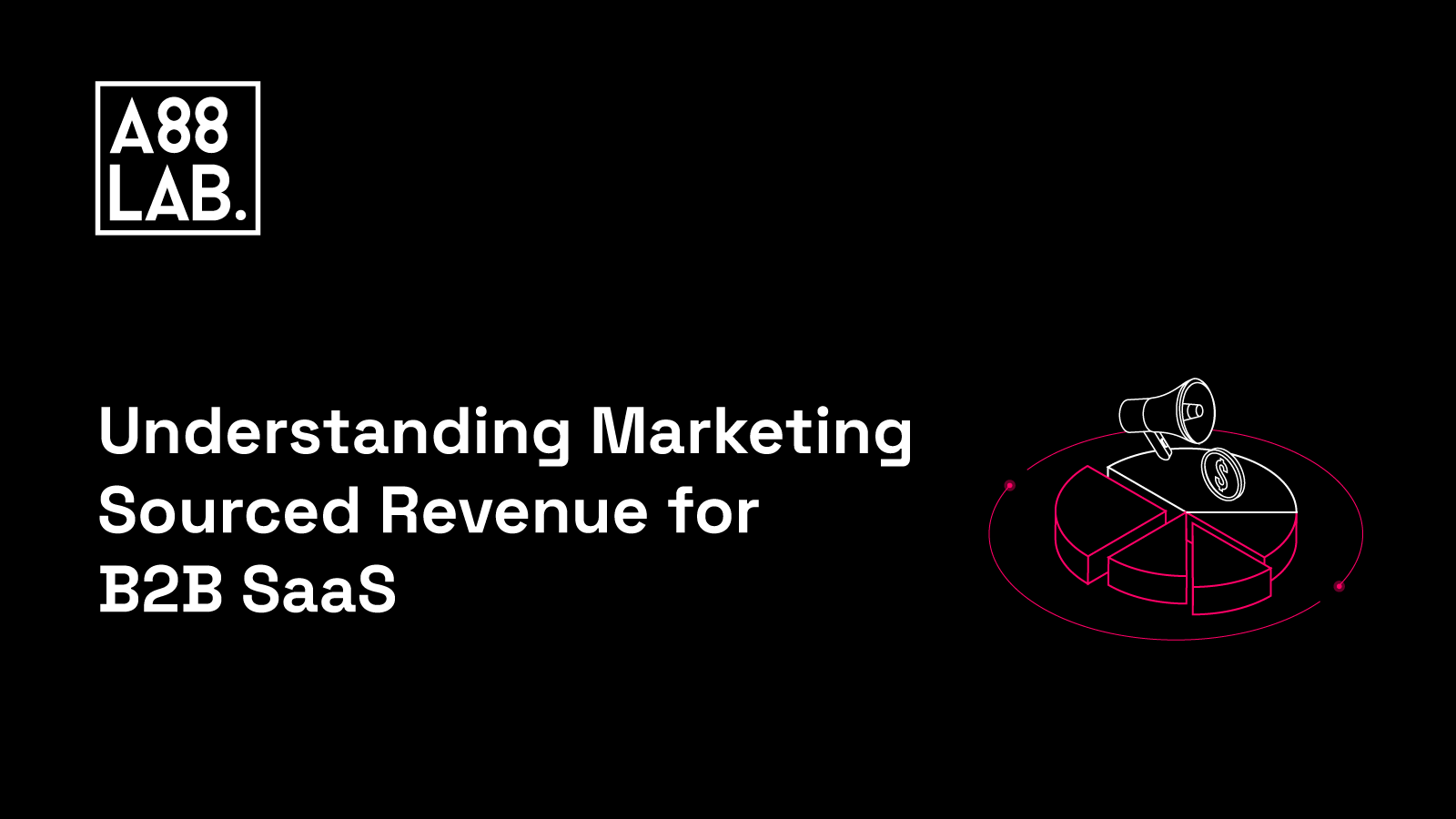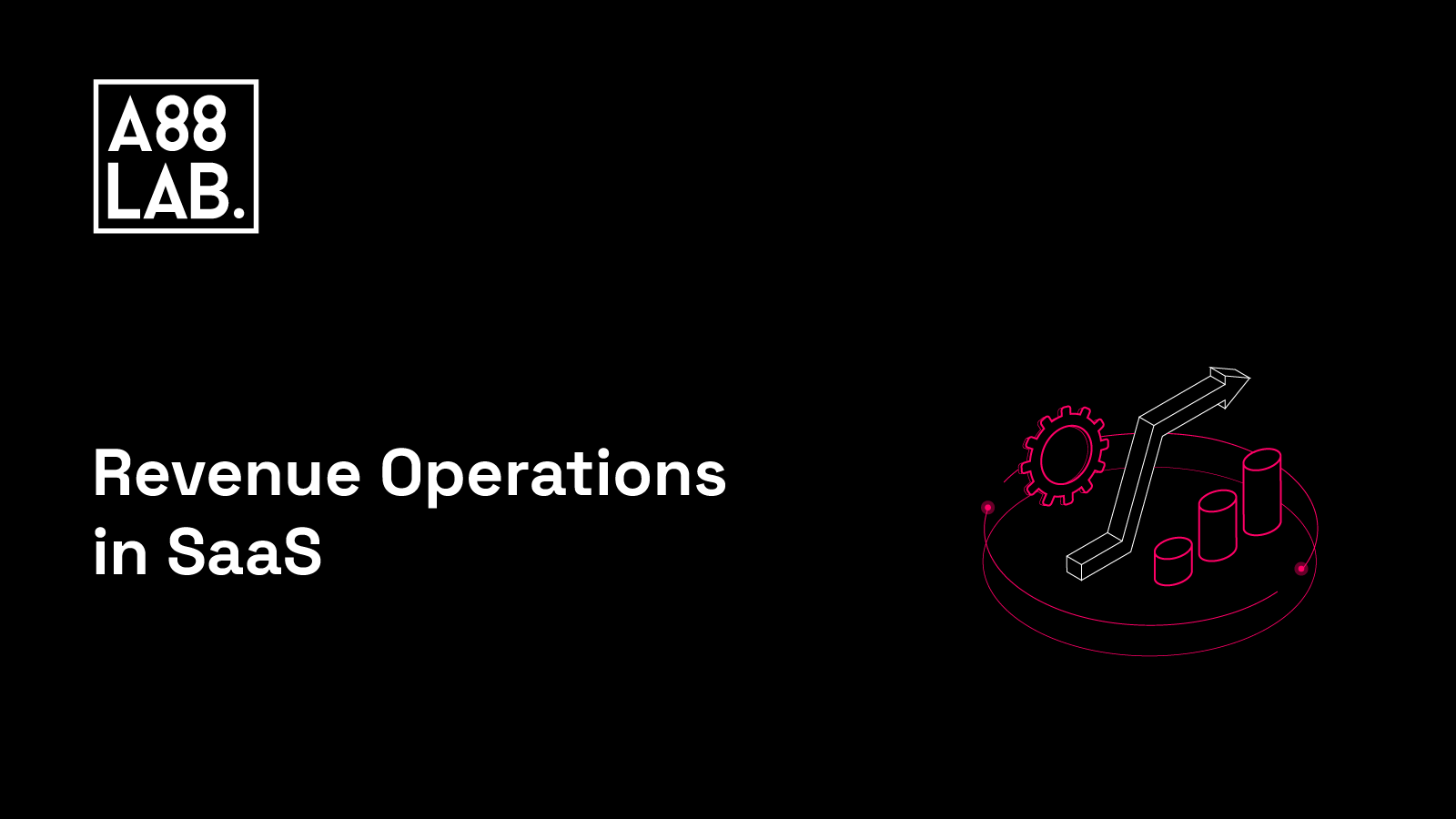One of the most common things we hear from clients in the SaaS world is, "We don't have any direct competitors." Now, don't get us wrong; sometimes, they're right. But more often than not, it's not that simple.
In the B2B SaaS industry, a conversation about category creation and differentiation is almost always on the table. The dilemma is: will creating a new category and carving out a segment of the market be beneficial in the long run? Or should we focus on better differentiation within existing categories?
We've all seen countless companies try and "out-innovate" the competition, adding new features and services to carve out a unique niche for themselves, and more often than not, they lose sight of customers in the process. When that happens, they struggle to gain traction and eventually fall off the radar.
Occasionally though, the right combination of features and services on the market, combined with a strong marketing strategy, can make all the difference. In this article, we'll take a look at the pitfalls of category creation and differentiation and discuss how businesses in the B2B SaaS industry can benefit from both.
Where Did the Talk About Category Creation Come From?
To dive into the concept of category creation, let's first define what it means and why it holds significance in the B2B SaaS landscape. Category creation is a term popularized by influential figures in the Silicon Valley startup world, such as Al Ramadan, Dave Peterson, Christopher Lochhead, and Kevin Maney, the authors of the book Play Bigger.
In their book, these industry experts examine the marketing, positioning, and awareness efforts of today's most notable unicorns and identify category creation as a key element for their unprecedented success. They argue that being the undisputed king of a specific category sets companies apart and propels them to greater heights.
Category creation builds upon the concepts introduced in earlier books like Positioning by Al Reis in 1981 and Crossing the Chasm by Geoffrey Moore in 1991. It represents the evolution of startup marketing strategies and has become a dominant force in the twenty-first-century startup landscape.
But What Is Category Creation?
Category creation, in its essence, involves the creation of an entirely new space within a specific market. It surpasses mere product or service innovation and focuses on introducing a completely novel way of addressing a problem or fulfilling a need.
It requires businesses to offer solutions that go beyond the existing category definitions and answer customer requirements not addressed by current offerings. In other words, it involves making a deliberate attempt to establish an entirely new market segment and become the leader of that space.
Some excellent examples of successful category creation include Hubspot, Uber, and Zoom. While taxis, hotels, and web conferencing products existed before them, and none of them invented their services from scratch, they did create a whole new way of providing them, which allowed them to gain massive traction in the market. In short, they found a pain point, named it, and created a new way to solve it.
These examples also showcase the common incorrect belief that category creation is all about being the first to introduce an innovative product or service. While it's true that certain businesses often benefit from being the pioneers of their categories due to the novelty factor, more often than not, it's not the first mover that ends up leading the new category. It's usually businesses with a clearer vision and an understanding of customer needs that are best positioned to lead a space.
The Power of Differentiation
Before we move on to discuss the factors that businesses need to consider when deciding between category creation and differentiation, let's take a closer look at the latter.
Differentiation is the process of distinguishing a business's product or service offerings from those of the competition by highlighting unique characteristics, value propositions, or customer experiences. It involves creating a distinct identity that resonates with target customers and positions the business as the preferred choice within a specific category.
In the B2B SaaS industry, differentiation can take various forms. It could involve offering unique features no other company provides, exceptional customer service, developing industry-specific expertise, or delivering a seamless user experience. Whatever the approach, the goal is to make a business stand out from its competitors by providing something they don't.
By building on what's already established in the market, businesses can benefit from existing demand. They don't have to struggle with "educating" customers on their product or service, as potential customers already understand the category and its offerings.
Differentiation also allows businesses to tap into the existing customer base of their competitors. By focusing on an improved version of what's already available, they can capture customers unsatisfied with their current provider or looking for a more advanced solution.
Horizontal vs. Vertical SaaS Differentiation
Now, just because a business opts for differentiation instead of category creation doesn't mean they have to take the same approach as everyone else.
On the contrary, there are two distinct ways of going about it in the B2B SaaS space: horizontal and vertical differentiation.
Horizontal SaaS
This approach involves offering a broad range of features and functionalities that can be applied across multiple industries or business functions. Horizontal SaaS solutions aim to cater to a wide customer base and provide a set of tools that can be customized to different industries or specific use cases.
The differentiation in horizontal SaaS comes from the versatility and flexibility it offers, allowing businesses to address a broader market and accommodate various customer requirements. In our experience, this approach is best suited for businesses with a low customer concentration and can be an excellent choice for companies targeting mid-market customers.
Vertical SaaS
In contrast, vertical SaaS focuses on serving a specific industry or niche market with tailored solutions that address industry-specific challenges and workflows. Vertical SaaS providers deeply understand the unique requirements and pain points of their target industry and offer specialized functionalities and domain expertise.
By narrowing their focus, vertical SaaS providers can differentiate themselves by delivering industry-specific value, expertise, and insights that generic horizontal solutions may lack. This approach is ideal for businesses targeting a highly concentrated customer base and can be particularly useful for companies looking to expand in enterprise markets.
As we've identified the two primary ways of differentiating in the B2B SaaS space, it's worth mentioning that going with differentiation also has its limitations. As mentioned earlier, businesses must ensure that their solutions offer something unique and clearly distinguish them from the competition.
Especially in the B2B SaaS world, where competition is fierce and customers are spoiled with choices, it's often difficult to build a strong enough identity to stand out from the rest. And if the competition offers more features, better service, or a more polished user experience, it's easy for customers to overlook your business.
Now, let's focus on a million-dollar question: Which is better? Should you focus on creating a completely new category or better differentiate yourself in an existing one?
Evaluating the Decision: Category Creation vs. Differentiation
As disappointing as this answer may be, it comes down to the unique context of each business. There is no playbook or one-size-fits-all solution that works for everyone. Many companies dive headfirst into tactical executions of one or the other without fully assessing what their target market is looking for or evaluating the long-term implications of their decision.
Based on our experience working with businesses in the B2B SaaS industry, we have observed certain trends and patterns that can help inform the decision between category creation and differentiation.
First and foremost, businesses need to understand that category creation requires more than just a game-changing product or an interesting tagline. It needs a powerful and consistent vision that permeates every aspect of your business, from product development to sales strategy, executive content, and marketing. Category creation cannot be outsourced to marketing alone if you expect it to succeed. It involves the entire organization and needs commitment from top to bottom.
So, why should you even go through the level of effort required to create a new category? Because if successful, you'll end up identifying the disease and offering the cure, which is a powerful position to be in.
On the other hand, differentiation is more tactical in nature and can often be managed by a single team. It doesn't require a complete overhaul of your business model or organization, but it does require you to pay attention to the details.
In this approach, businesses focus on improving the user experience or introducing more features to stand out from the competition. It requires a deep understanding of customer needs and the current competitive landscape and also involves creating a distinct identity that customers can easily identify.
While the decision between category creation and differentiation should be made on a case-by-case basis and is heavily dependent on the context of each business, there are certain factors we take into consideration when helping our clients reach a decision.
Market Dynamics and Competition
Assessing the market dynamics and the competitive landscape is the first step in determining whether to focus on category creation or differentiation.
If your research reveals there's an existing demand for a product or service similar to yours, then differentiation is probably the best approach. It allows you to focus on existing customer needs and tap into a larger market of potential buyers.
But if your research shows that there's an unmet need in the market or no existing solution to solve a certain problem, that's a first hint that category creation might be the way to go.
To fully understand the market dynamics, it's also crucial to have an understanding of customer journeys and the impact of various touchpoints. This is where a hybrid attribution model can be beneficial, as it combines multiple attribution approaches to provide a more accurate assessment of the effectiveness of different marketing strategies and tactics.
Resource Allocation and Risk
What resources are you willing to allocate to the process? Category creation often involves significant resource allocation, including research, development, and marketing efforts. It's also risky, as it requires businesses to go against the grain and challenge a well-established status quo, educate potential customers, and build an audience from scratch.
Conversely, differentiation leverages existing market demand and can be implemented with less upfront investment. It also carries less risk, as it doesn't involve disrupting the market or introducing a completely new concept.
Competitive Advantage and Sustainable Differentiation
Let's think for a second about the potential for long-term competitive advantage. Category creation offers the opportunity to establish a unique position as the pioneer and leader in a new space. It's also an opportunity to build a brand identity that goes beyond a mere product or service and positions the business as an industry expert.
However, sustaining that advantage is where many companies fail, as the competition is always lurking. If you manage to create a new category, you'll need to keep improving your offer and work hard to stay in the lead.
Differentiation, if executed effectively, can also help your business build a strong identity and stand out from the competition. The key is to focus on creating lasting value for customers instead of a quick-fix solution. To delve deeper into the importance of value-focused messaging on your website, we recommend reading the article 'Beyond Revenue: Why Your Website Messaging Needs to Focus on Value, Not Just Money’.
Customer Perception and Market Education
Will your customers be willing to adopt the new concept or even understand it? As important as market dynamics are, they can never be a substitute for customer perception. Every business should assess the level of market education they're willing and able to commit to for customers to understand their new concept.
Category creation comes with a fair share of educating the market about the problem, its solutions, and the benefits of the new approach. It can be time-consuming and may require a significant investment in content creation, thought leadership activities, and marketing initiatives.
If you feel like it's too complicated, there is too much resistance to the new concept, or you don't have the resources to educate customers, then differentiation is probably the way to go.
Marketing and Positioning Strategy
Finally, whichever approach you decide to take, it won't go far without a well-thought-out marketing and positioning strategy, let by detailed customer segmentation.
For category creation, it involves creating awareness, driving adoption, and establishing thought leadership in the new category. Your marketing strategies should focus on demand generation and customer education and emphasize the long-term benefits of your solution.
If differentiation is the way to go, you should focus more on communicating the unique benefits and value propositions of your offer. Your message should be clear, consistent, and tailored to each customer segment. Your marketing and positioning strategies should be designed to differentiate your business from the competition and create a strong brand identity.
Final Words
There aren't many professional experiences as exciting and rewarding as creating a brand new category, especially in the B2B SaaS landscape. It requires a healthy dose of patience, resources, and risk-taking, but if done correctly, there is no greater reward than customers telling you they can't remember what doing their job was like before your solution.
At the same time, if you feel like you're not ready for such an ambitious undertaking, don't push it. You will find yourself in a heated competitive battle or struggling to gain market traction, so it's better to focus on what you do best: differentiate your offer, build an audience, and consistently improve the customer experience. In the end, if you can tell a story that people want to hear and set yourself apart from the competition, the waves will follow.
.png)


